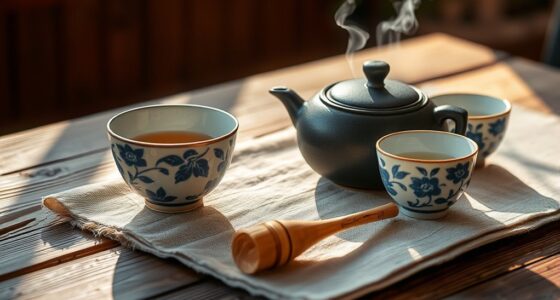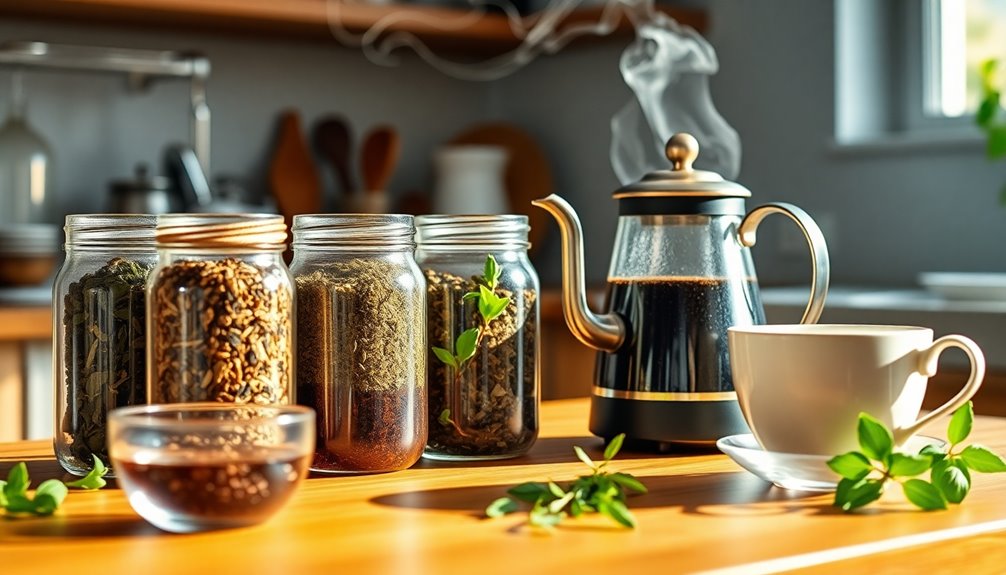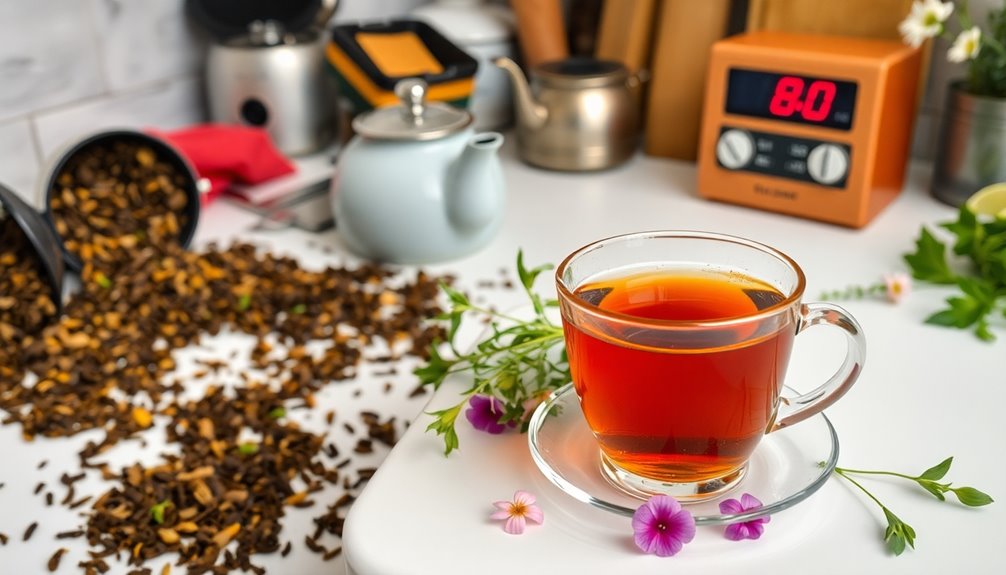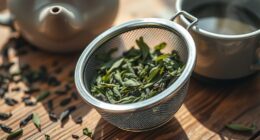Oolong tea’s flavor and aroma depend heavily on its oxidation level, which ranges from 10% to 70%. Lightly oxidized oolongs (around 10-30%) tend to have fresh, grassy, or floral notes similar to green teas, while more heavily oxidized ones (50-70%) develop richer, roasted, or fruity flavors. The oxidation process shapes the tea’s character and health benefits. Exploring different levels helps you uncover a broad flavor spectrum—if you want to learn more, explore how each level influences your tea experience.
Key Takeaways
- Oxidation levels in oolong range from 10% to 70%, affecting flavor from fresh and grassy to deep and roasted.
- Lightly oxidized oolongs (10-30%) retain floral, green, and fruity notes ideal for bright, refreshing flavors.
- Heavily oxidized oolongs (50-70%) develop rich, caramelized, and roasted profiles resembling black teas.
- Understanding oxidation helps home tasters select teas matching desired flavor profiles and health benefits.
- Exploring different oxidation degrees allows for a personalized flavor map, enhancing the tea tasting experience.

Oolong oxidation levels play a crucial role in determining the flavor, aroma, and appearance of this popular tea. As a home taster, understanding how different processing methods influence oxidation can help you select the perfect brew for your palate. Oolong teas are unique because they fall between green and black teas in terms of oxidation, typically ranging from 10% to 70%. This range results from specific processing steps, including withering, bruising, partial oxidation, and firing. Lightly oxidized oolongs, like those at the lower end of the spectrum, retain more of the fresh, grassy notes similar to green teas, while more heavily oxidized varieties develop deeper, roasted, or fruity flavors akin to black tea. By recognizing these distinctions, you can better appreciate the nuanced flavor map of oolong teas.
Processing methods are central to shaping these oxidation levels. After harvesting, the tea leaves undergo withering to reduce moisture, then are gently bruised or shaken to initiate oxidation. The degree and duration of this oxidation are carefully controlled, often by applying heat to halt the process at specific points. This meticulous control allows producers to craft a wide array of flavor profiles, from lightly oxidized, floral teas to rich, caramelized ones. As a home taster, knowing that these steps directly impact flavor can guide you in selecting teas that match your mood or preference, whether you crave something light and invigorating or bold and robust.
In addition to influencing flavor and aroma, oxidation levels also affect the health benefits of oolong teas. Generally, lighter oolongs preserve more antioxidants, which can promote metabolism, improve heart health, and support overall well-being. Heavier oolongs, while slightly oxidized, still retain beneficial compounds, but the process can alter some of their antioxidant content. Understanding these differences helps you make informed choices not only for taste but also for health. For example, if you’re seeking a tea with higher antioxidant levels, opting for a lightly oxidized oolong might be your best bet.
Ultimately, the processing methods that determine oxidation levels are what give each oolong its distinctive character. As a home enthusiast, exploring different oxidation degrees allows you to discover a spectrum of flavors and benefits. Whether you prefer the fresh, floral notes of lightly oxidized teas or the rich, roasted qualities of more heavily oxidized varieties, understanding these nuances empowers you to craft a personalized tea experience. Paying attention to how the processing impacts both flavor and health benefits can turn your tea routine into a deeper, more rewarding journey.
Frequently Asked Questions
How Do Oxidation Levels Affect Brewing Time?
Oxidation levels directly influence brewing time because they affect flavor development and how quickly the tea releases its flavors. Higher oxidation teas often require shorter steeping to prevent bitterness, while lower oxidation teas may need longer to fully develop their subtle notes. By controlling oxidation, you can tailor your brewing time to enhance flavor, ensuring a balanced cup. Adjust your steeping based on oxidation control to enjoy the best flavor profile.
Can Oxidation Levels Change Over Storage?
Think of your oolong tea like a delicate dance partner; it can change its moves over time. Storage impact can cause oxidation levels to shift, especially if exposed to air or light, reducing oxidation stability. While some oxidation may deepen flavor, excessive changes can make your tea taste off. To keep your tea fresh and maintain its original character, store it in an airtight container away from heat and light.
Are There Health Benefits Linked to Specific Oxidation Levels?
You might wonder if certain oxidation levels in oolong tea offer health benefits. Generally, teas with higher oxidation have more antioxidant properties, which can help combat free radicals. Some oxidation levels also support digestion benefits, easing stomach discomfort. So, choosing oolong with the right oxidation level can boost your antioxidant intake and improve digestion, making your tea experience both flavorful and healthful.
Which Oxidation Level Is Best for Making Iced Oolong Tea?
For making iced oolong tea, you’ll find that lightly oxidized oolong works best. It offers a smooth, floral flavor that holds up well in cold brew, enhancing the tea’s natural sweetness without bitterness. Cold brew extracts subtle flavors efficiently, making it ideal for iced tea. Opt for a lower oxidation level if you want a invigorating, flavor-enhanced iced oolong experience that’s easy to enjoy on hot days.
How Do Oxidation Levels Influence Oolong Tea’s Caffeine Content?
You might wonder how oxidation levels influence oolong tea’s caffeine content. Oxidation impact varies, causing caffeine variation: more oxidized teas tend to have slightly lower caffeine, while less oxidized ones often contain more. However, other factors like processing and brewing methods also matter. So, if you’re seeking a caffeine boost, opt for lighter, less oxidized oolongs, but remember, the overall caffeine content can still differ based on how you prepare the tea.
Conclusion
As you explore oolong oxidation levels, you’ll notice how subtle changes open new flavors, turning each sip into a delightful discovery. Coincidentally, the more you taste, the more you understand—like a dance between your palate and the tea’s transformation. So, keep experimenting, trust your senses, and enjoy the journey. After all, every cup reveals a little more, making your tea experience uniquely yours with every brew.










